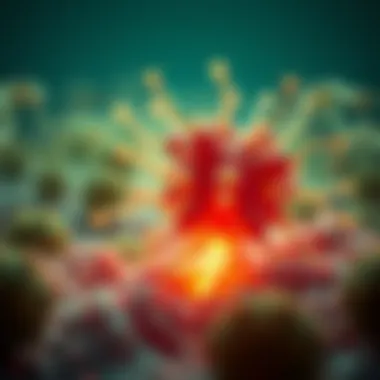Understanding Resistant Microorganisms: Insights and Implications


Intro
As we navigate the rapidly changing landscape of both health and agriculture, one topic stands under the spotlight: resistant microorganisms. These are not just abstract concepts, but real-life entities that impact our crops, livestock, and even our own bodies. Understanding what makes bacteria, fungi, and other microorganisms resistant to treatments can significantly influence how we manage diseases, ensure food security, and protect public health.
This exploration will take us through various essential aspects of resistant microorganisms—from the terminology that defines them to the latest research and practical strategies that can make a difference. This understanding is essential for farmers, agricultural enthusiasts, and healthcare professionals alike.
Key Concepts and Terminology
Definition of Terms
When diving into the world of resistant microorganisms, it’s crucial to first grasp some key terms:
- Antibiotic Resistance: This refers to the capacity of microorganisms to survive the effects of medications designed to kill them or inhibit their growth. When bacteria become resistant, infections can become harder to treat, leading to longer hospital stays or increased mortality.
- Pathogen: These are microorganisms capable of causing disease. Common examples include certain strains of E. coli, Salmonella, and Staphylococcus aureus.
- Genetic Mutations: Referring to changes in the DNA sequence of a microorganism, these mutations can contribute to resistance by altering how a pathogen reacts to treatment.
- Horizontal Gene Transfer: This is a mechanism by which bacteria can share genetic material, including those conferring resistance, with each other, leading to the rapid spread of resistant traits.
Understanding these terms provides a solid foundation for grasping the broader implications of resistant microorganisms.
Overview of Relevant Practices
In agriculture, managing resistant microorganisms isn't just about understanding the science; it also involves practical approaches. Some prevalent practices include:
- Integrated Pest Management (IPM): Using various methods to manage crop pests and diseases, including biological controls, crop rotation, and resistant varieties.
- Judicious Use of Antibiotics: In livestock, it's vital to use antibiotics only when necessary to reduce the chances of developing resistance in bacteria.
- Regular Soil Testing: Knowing the health of soil microbiomes can help in making informed decisions about crop rotation and amendments at a micro-level.
These practices are essential in curbing the impact of resistant strains in both agriculture and health, ensuring a balanced approach to managing these microorganisms.
Current Trends and Innovations
Latest Research and Developments
Research is relentlessly advancing our understanding of resistant microorganisms. Recent studies have emphasized:
- The role of environmental factors, like climate change, in influencing resistance patterns.
- Innovations in genetic studies can speed up the identification of resistant strains, aiding quicker response strategies.
For instance, scientists are now able to track resistance genes in microbial populations through advanced sequencing technologies, allowing for more targeted interventions.
Emerging Technologies and Tools
A handful of technologies are stepping onto the stage to help combat resistant microorganisms:
- CRISPR-Cas9: This gene-editing technology allows for precise modifications in microbial DNA, potentially reversing resistance characteristics.
- Bacteriophage Therapy: This approach uses viruses that specifically infect bacteria, offering a potential alternative to traditional antibiotics.
These innovations might not only mitigate current resistance but also pave the way for future practices in both healthcare and agriculture.
Practical Applications
Step-by-Step Guides
Understanding resistant microorganisms is one thing; knowing how to deal with them is another. Here’s a step-by-step guide for farmers:
- Conduct Regular Soil Tests: This checks the health of your soil and microbial population, helping you identify any emerging resistant strains.
- Rotate Crops Appropriately: Changing the types of crops planted can disrupt the life cycles of both pests and pathogens, reducing their resistance potential.
- Educate Yourself and Staff: Keeping everyone informed about the most recent research on resistance contributes towards unified management strategies.
Troubleshooting Common Issues
Resistance may sometimes crop up unexpectedly. Here’s how you can troubleshoot:
- If a treatment doesn’t seem to be working, reconfirm the diagnosis. Sometimes, what looks like a resistant infection might be something entirely different.
- Keep records of treatments and outcomes to observe patterns which can help identify potential resistance issues early on.
"Understanding resistant microorganisms is not just a scientific endeavor; it’s an essential component of modern agriculture and health care that demands our attention and action."
With consistent efforts, education, and strategic planning, managing resistant microorganisms can become a challenge that we can confront head-on, ensuring the safety of our health and the sustainability of our agricultural practices.
Prolusion to Microorganisms
Microorganisms, despite their unseen size, play a monumental role in the natural world and human life. From the most humble bacteria to complex fungi, these microscopic entities are the unsung heroes and, occasionally, the foes in our ecosystems. Understanding microorganisms is vital not only from a scientific standpoint but also for its practical implications in health and agriculture, where resistant organisms present particular challenges.
The significance of diving into the diversity of microorganisms lies in recognizing their multifaceted existence. Each type, whether it's archaea, bacteria, viruses, or fungi, contributes uniquely to various ecological and human processes. This knowledge equips us to appreciate how they interact, influence one another, and the environments they inhabit. Moreover, grasping such complexities can enable us to devise strategies to combat adverse effects, especially those caused by resistant microorganisms.
Benefits of Understanding Microorganisms
- Enhanced Agricultural Practices: Insights into microbial life can bolster crop yields through better soil health and pest management. For instance, understanding the role of beneficial bacteria in enhancing soil quality might shift farming practices in favor of sustainability.
- Informed Healthcare Solutions: On the health front, an intricate understanding can lead to better treatment protocols and the development of new medicinal strategies against resistant strains, improving public health outcomes.
- Ecological Balance: Knowledge of these microorganisms aids in maintaining the balance within ecosystems, guiding conservation efforts and influencing biodiversity positively.
Considerations
It’s crucial to acknowledge that not all microorganisms are beneficial. Some pathogens can wreak havoc, especially when resistance mechanisms allow them to survive antibiotic treatments. The prevalence of such resistant strains—ones that thrive against our best efforts—drives home the importance of continued research and education in this field.
As we delve into the specifics of this intricate realm, it becomes clear that the fate of health systems and agricultural productivity may well rest on our understanding of these tiny creatures. The upcoming sections will explore how diverse microorganisms are, their functional roles in ecosystems, what resistance means in this context, and how this knowledge is pivotal for future strategies.


Definitions of Resistance
Understanding the definitions of resistance is crucial within the context of resistant microorganisms. This section provides the foundational knowledge necessary to grasp the complexity of resistance phenomena. Resistance isn't merely a buzzword in contemporary discussions; it is a pressing issue that intertwines with various sectors, notably health and agriculture. Clear definitions allow stakeholders to identify resistant organisms effectively, which is essential for developing strategies to combat their spread.
What Are Resistant Microorganisms?
Resistant microorganisms are those pathogens that show an ability to withstand treatments meant to eliminate or control them. This includes bacteria, fungi, parasites, and viruses. They possess capabilities that allow them to persist, even when exposed to antibiotics or antimicrobials that would typically be fatal. This defiance leads to higher medical complications, extended hospital stays, and in some cases, increased mortality.
One significant aspect of these organisms is their adaptability. They do not simply survive but can thrive in adverse conditions, making them particularly troublesome in healthcare settings. Addressing their impact requires an understanding of how resistance develops and spreads among populations of microorganisms.
Types of Resistance Mechanisms
The mechanisms by which microorganisms acquire resistance are varied. They can broadly be classified into different categories, each highlighting various aspects of their survival capabilities.
Genetic mutations
Genetic mutations are one of the primary ways resistant microorganisms evolve. These mutations can happen randomly during replication or can be induced by external pressures, such as the presence of antibiotics. A crucial characteristic of genetic mutations is that they can result in significant alterations in the microorganism's physiological functions, providing them with survival advantages. For instance, a mutation might change a bacterial enzyme so that the antibiotic can no longer bind effectively, rendering the treatment futile.
This form of resistance is beneficial as it serves a dual purpose: it is a natural response and can also lead to rapid changes in the population dynamics of these microorganisms. However, over-reliance on mutations can lead to unforeseen vulnerabilities, as some mutations may not confer stability in changing environments. Hence, while genetic mutations ensure survival, they may come with trade-offs that affect long-term viability.
Acquisition of resistance genes
Acquisition of resistance genes is another vital mechanism that emphasizes how bacteria can share resistance traits. Often, these genes come from neighboring resistant strains through a process called horizontal gene transfer. This characteristic is noteworthy because it means that even non-resistant microorganisms can suddenly become formidable adversaries if they acquire a gene from a resistant peer.
The unique feature of this mechanism is its rapid pace; one can observe entire populations shifting in a matter of days. While it might seem advantageous as it creates diversity within microbial communities, it also complicates treatment strategies. There’s the risk of developing strains that are resistant to multiple drugs, severely limiting treatment options.
Biofilm formation
Biofilm formation is a sophisticated defense mechanism employed by many microorganisms. They create a protective layer that shields them from external threats, including antimicrobial agents. This characteristic is critical as biofilms can form on various surfaces, from industrial equipment to human tissues.
By establishing a biofilm, microorganisms gain a unique advantage. The dense community provides a cooperative living environment where individual cells can share nutrients and genetic material, enhancing their survival chances. Though biofilms can be challenging to eradicate, the downside is that they tend to accumulate in treatment sites and can become a reservoir for chronic infections that conventional therapies struggle to address.
"Resistance mechanisms like genetic mutations, gene acquisition, and biofilm formation highlight the adaptability of microorganisms in the face of adversity and serve to remind us of the ongoing battle between microbial survival and antimicrobials."
Mechanisms of Resistance Development
The exploration of mechanisms underpinning the development of resistance in microorganisms is crucial to understanding the larger implications these organisms have in both healthcare and agriculture. As resistance grows and spreads, not only do we face hurdles in treatment options for diseases, but productivity in farming can also be severely impacted. The knowledge of how these resistances form can illuminate paths toward effective solutions, ultimately fostering a more resilient and sustainable future.
Natural Selection and Evolution
Natural selection plays a significant role in the evolution of resistant microorganisms. Generally, it implies that those microorganisms which can survive exposure to antibiotics or pesticides will thrive and reproduce, passing those advantageous traits to their offspring. This process is especially prevalent in environments where these compounds are used frequently, creating a selective pressure that drives evolution. For instance, the widespread use of antibiotics such as penicillin has led to the emergence of resistant strains of bacteria.
In the context of agriculture, the continuous application of pesticides fosters a similar dynamic. Unintended consequences arise when pests and pathogens develop resistance to treatments intended to eliminate them. An example is the cotton bollworm, where populations previously controlled by Bacillus thuringiensis (Bt) have developed resistance, leading to a resurgence in pest populations. The evolutionary arms race that ensues emphasizes the urgent need for switched tactics and integrated management strategies.
The take-home message here is that the very ways we attempt to control these microorganisms can lead to their rapid adaptation and eventual resistance.
Plasmid Transfer and Gene Sharing
Another potent mechanism for the development of resistance is through plasmid transfer and gene sharing. Plasmids are small, circular pieces of DNA that can replicate independently within a bacterial cell. They often carry genes that confer traits such as antibiotic resistance. One of the most concerning aspects of plasmid transfer is that it can happen between different bacterial species—a phenomenon known as horizontal gene transfer.
This transfer occurs mainly through three mechanisms: transformation, transduction, and conjugation. Transformation involves the uptake of naked DNA from the environment, while transduction is mediated by bacteriophages, viruses that infect bacteria. Conjugation, perhaps the most direct method, involves one bacterium transferring genetic material to another through direct contact.
In agriculture, the implications of gene sharing cannot be overstated. For example, if fungal pathogens acquire resistance genes from bacterial plasmids, farmers might face rampant infestations that no longer respond to fungicides. The result can be catastrophic—decreased yields, increased costs, and higher pesticide application rates to combat these evolved strains.
Understanding these mechanisms not only aids in the development of novel treatments but reinforces the importance of responsible use of antibiotics and pesticides in both healthcare and agricultural sectors. By recognizing how resistance emerges and spreads, we can better strategize our approaches to prevention and control.
Impact on Human Health
The implications of resistant microorganisms on human health can't be understated. They mark a critical shift in the landscape of healthcare, driving new challenges and considerations. As these organisms evolve, they pose heightened risks, prompting us to rethink our approaches to treatment and prevention. With rising numbers of multi-drug resistant strains, the healthcare sector faces serious hurdles. This section focuses on how microbial resistance not only complicates treatment but magnifies public health risks, demanding urgent action from both providers and policymakers.
Resistance in Clinical Settings
In clinical environments, the emergence of resistant microorganisms reshapes patient care. Hospitals and healthcare facilities are particularly vulnerable, as infections can spread like wildfire. When a patient arrives with an infection, the typical response involves administering antibiotics. However, with resistance, these first-line treatments often fall flat. The stakes are high here, and medical professionals must navigate a treacherous path, balancing effective treatment with the risk of worsening resistance.
Furthermore, the presence of resistant strains complicates diagnoses. Healthcare providers rely on laboratory results to determine the best therapeutic approach. When these results indicate resistance, clinicians are forced to select alternative, often more potent antibiotics, which may harbor their own side effects or lead to harmful consequences like secondary infections.
Challenges in Treatment
Increased morbidity rates
Increased morbidity rates resulting from resistant infections present a grim reality. Particularly, individuals with compromised immune systems or chronic conditions are at heightened risk. The unique characteristic of this aspect lies in its capacity to exacerbate existing health issues. Moreover, as more patients fall ill, healthcare systems become increasingly strained.
This is a notable choice to discuss because it highlights the urgency of addressing resistance. The longer these microorganisms go unchecked, the greater the burden on both patients and health systems. The frequent need for prolonged hospital stays and intensive care also leads to complex recovery journeys for affected individuals.
Antibiotic shortages
Antibiotic shortages have emerged as another serious challenge fueled by resistant microorganisms. As resistance gains momentum, the well of available treatments dries up. The distinctive side of antibiotic shortages is the direct emotional toll on healthcare providers and patients alike, as they grapple with limited options in dire situations.


The detrimental impact of such shortages shouldn’t be overlooked, as it leads to treatment delays and growing rates of untreated infections. This, in turn, raises critical questions about the sustainability of our healthcare frameworks.
Increased healthcare costs
Increased healthcare costs constitute a fundamental aspect when discussing resistant microorganisms. The continued battle against these organisms creates a detrimental cycle; as treatment strategies become more intricate, costs rise steeply. A key characteristic of increased healthcare expenses is its ripple effect, where patients impacted by resistant infections face prolonged illnesses, leading to lost income and additional expenses.
Given the context of this article, increased healthcare costs warrant attention due to their implications for both individuals and systemic healthcare structures. While effective management of resistant infections may incur higher short-term costs, the long-term focus remains on preserving health and curbing the spread of resistance.
"Addressing resistant microorganisms requires thorough engagement from the healthcare sector and the public to safeguard global health."
In summary, the intersection of resistant microorganisms and human health reveals a complex and multifaceted issue. Ongoing challenges in clinical settings and rising costs necessitate dedicated adaptive strategies. To mitigate these threats, collaboration between healthcare professionals, researchers, and communities proves essential. The need for innovative approaches to treatment and prevention has never been more pressing.
Consequences for Agriculture
The implications of resistant microorganisms extend into the agricultural domain, creating a significant ripple effect on farming practices and food production. As farmers navigate the complexities of pest control and crop health, the challenges posed by resistance can shape their strategies and ultimately affect yields and profitability. Understanding these consequences is vital, as they underscore the urgent need for adaptable practices and informed decision-making.
Pesticide Resistance
Pesticide resistance is a pressing concern within agriculture, complicating the battle against pests and diseases that threaten crops. Resistance occurs when pest populations evolve to withstand the effects of chemical controls that previously managed them effectively. This development not only signifies the shifting dynamics in agricultural ecosystems but also highlights the importance of sustainable practices.
Farmers often face a paradox: in their efforts to eradicate pests, they may inadvertently contribute to the resilience of these organisms. As a case in point, the overuse of glyphosate—a widely employed herbicide—has led to a sharp increase in resistant weed species. As these resistant strains proliferate, they become dominant, rendering the original treatments ineffective. The repercussions of pesticide resistance are multifaceted, influencing everything from crop viability to economic stability in agricultural communities.
"Today’s pests are tomorrow’s challenges; understanding resistance is key to sustainable agriculture."
Impact on Crop Yields
The impact of resistant microorganisms on crop yields cannot be overstated. As these microorganisms adapt and become resilient, the effectiveness of treatments wanes, leading to significant agricultural challenges. This decline is evident through two main lenses: reduced treatment effectiveness and increased pest management costs.
Reduced effectiveness of treatment
The reduction in treatment effectiveness is a critical issue that arises when pests develop resistance. In simpler terms, the very tools farmers rely on to protect their crops lose their power over time. This phenomenon occurs when repeated applications of the same pesticide lead to a survival of the fittest scenario among pests. Indeed, when these pests begin to outsmart the chemical solutions, crops face increased pressure from infestations, leading to losses in yield and quality.
One distinctive feature of this problem is the inevitable cycle it creates. Farmers, in desperation, often resort to heavier applications of existing chemicals or turn to more potent alternatives. However, such measures can lead to environmental repercussions and might not guarantee a long-term solution.
Increased pest management costs
Rising pest management costs emerge as another significant consequence of resistant microorganisms. As treatment effectiveness dwindles, farmers find themselves needing to invest more—both in quantity of pesticide and in the development of new pest control strategies. This increased expenditure can strain budgets and make it harder for smaller farms to operate competitively. Moreover, the pivot towards more intensive management practices could necessitate additional labor and resources, thereby escalating costs further.
A pivotal concern here is the financial sustainability of farming given that increased pest management costs could diminish overall profitability. Farmers may find themselves squeezed between the need for effective control measures and the rising costs associated with these interventions, ultimately putting their livelihoods at risk.
In summary, the consequences for agriculture stemming from resistant microorganisms manifest in substantial ways, underscoring the precarious balance farmers must maintain in their practices. Understanding these dynamics is crucial for shaping future agricultural policies and strategies.
For additional reading on sustainable agricultural practices, check out resources from USDA and Cornell University's Integrated Pest Management.
Strategies for Mitigation
In today’s rapidly evolving landscape, understanding and implementing effective strategies for the mitigation of resistant microorganisms is crucial. As the world faces rising challenges linked to these organisms, it’s essential to explore tailored strategies that not only address immediate concerns but also promote long-term sustainability in both healthcare and agricultural practices. This section delves into methods that are practical and effective while fostering a culture of responsibility among those involved in these sectors.
Integrated Pest Management
Integrated Pest Management (IPM) embodies a holistic approach to controlling pests while minimizing risks to health and the environment. This strategy goes beyond mere chemical control, blending several methods to manage pest populations effectively. By utilizing biological control methods, such as encouraging natural predators alongside scouting for pest populations, farmers can achieve equilibrium in their ecosystems.
A key benefit of IPM is its focus on sustainability. Pesticide resistance can lead to decreased efficiency of treatments and increased production costs over time. By integrating various control tactics, farmers often find they can effectively manage pests without relying heavily on chemical solutions.
Consideration of local ecosystems and timing of interventions also plays a role in IPM. For example, understanding pest life cycles can lead to better-targeted pest control strategies. This adaptability not only protects crop yields but ultimately supports environmental health as it aims to reduce the chemical load on farmland.
Antibiotic Stewardship
Antibiotic stewardship is vital in curbing the rise of resistant microorganisms within clinical settings. It emphasizes the responsible use of antibiotics to minimize misuse and over-prescription, which are prominent contributors to resistance. This strategy promotes appropriate prescribing practices, encouraging healthcare providers to assess patient needs carefully before administering antibiotics.
Key attributes of effective antibiotic stewardship programs include:
- Regular training and education for healthcare staff regarding the latest resistance patterns.
- Data-driven approaches to monitor and evaluate antibiotic prescribing.
- Guidance for alternative treatments or de-escalation of therapy when appropriate.
By fostering a culture of responsible use and promoting awareness among practitioners, this approach not only enhances patient care but also benefits public health by mitigating the risk of spreading resistant strains.
Research and Development
Fostering a dedicated research and development environment is essential for innovative solutions that address the threats posed by resistant microorganisms. Through funding and initiatives targeted at expanding knowledge in this field, researchers can unveil newer alternatives and improvements in treatment protocols.
Novel Treatments
One aspect of this focus on research is the exploration of novel treatments for resistant infections. These include exploring phage therapy or antimicrobial peptides that offer a different mechanism of action against pathogens. The key characteristic of novel treatments lies in their ability to combat organisms that have developed resistance to traditional antibiotics. This can provide hope for patients where options are dwindling.
However, challenges remain. The development of these treatments often requires significant investment and time to ensure safety and efficacy. Still, as resistance escalates, the exploration of these avenues becomes increasingly necessary and popular, as they represent a promising frontier in the ongoing battle against resistant microorganisms.


Adaptive Strategies
Adaptive strategies seek to respond dynamically to the patterns of resistance observed in real-time. This might involve altering treatment protocols based on local resistance profiles or employing vaccination strategies to reduce the prevalence of certain infections altogether. The unique feature of adaptive strategies is their flexibility, allowing healthcare providers to pivot based on emerging data and to tailor responses as new information becomes available.
Advantages of implementing adaptive strategies include a more personalized approach to treatment which not only improves patient outcomes but also addresses the broader public health implications of resistance. However, coordinating such adaptive systems requires robust data collection and analysis, which can be resource-intensive but ultimately pays dividends in managing resistance effectively.
"Mitigation strategies must consider the balance between immediate agricultural needs and long-term ecological sustainability. The cost of inaction can far outweigh the investment in effective strategies."
Role of Education
Education serves as a cornerstone in the struggle against resistant microorganisms. It plays a pivotal role in shaping the knowledge and attitudes of individuals within both healthcare and agricultural sectors. Understanding the biological mechanisms behind resistance is vital for informed decision-making.
In healthcare, educating professionals fosters improved diagnostic and treatment protocols. Proper training can equip healthcare providers to implement effective antibiotic stewardship, reducing the risk of resistance development. For instance, a well-informed physician is likely to scrutinize when and how antibiotics are prescribed, leading to fewer unnecessary prescriptions.
On the agricultural front, awareness campaigns can significantly influence farming practices. Studies have illustrated that training farmers on resistance mechanisms, such as the introduction of resistant strains of pests to pesticides, can lead to more sustainable practices. These simple changes, like rotating crops or adjusting pesticide use, can make a tremendous difference.
"Education is the most powerful weapon which you can use to change the world."
— Nelson Mandela
The importance of education cannot be overstated. Through consistent and thorough training, stakeholders can adapt more rapidly to emerging threats, ultimately fostering a culture of responsibility and proactivity.
Training Healthcare Professionals
Training healthcare professionals in understanding the implications of resistant microorganisms is crucial. A well-rounded curriculum that covers the molecular biology of resistance, the significance of prudent antibiotic prescribing, and the role of patient education can all help curb the spread of resistance.
Furthermore, simulation-based training can enhance diagnostic skills. When healthcare professionals engage in real-world scenarios—like identifying resistant infections—they better grasp their implications. Regular workshops and updates on the latest research in microbiology can keep practitioners on their toes, lessening the chance for outdated practices to take root.
Awareness in Agriculture
Awareness in agriculture about resistant microorganisms is equally essential. Farmers who understand the resistance issues associated with pesticides and fertilizers can adapt their strategies effectively. This includes rotating the types of chemicals used or even exploring alternative methods such as integrated pest management tactics.
Additionally, creating platforms for sharing best practices can amplify the impact. Online forums, community workshops, and formal training can bridge the knowledge gap within farming communities. Many small-scale farmers may not have access to updated information, which could lead to practices that inadvertently promote resistance.
In summary, integrating education into both medical and agricultural practices stands as one of the most effective methods to mitigate the looming threat of resistant microorganisms. The more informed the population is, the better equipped they will be to handle and prevent resistance, ultimately aiming for a healthier ecosystem.
Future Perspectives
Exploring the landscape of resistant microorganisms is not just a deep dive into the biology of these organisms but also a crucial eye on the future, especially in agriculture and healthcare. The implications of microbial resistance demand attention and spark innovation. The future perspectives in dealing with resistant microorganisms carry considerable weight; they can reshape strategies, enhance treatment options, and delve into preventive measures that protect both human health and crop yields.
1. Importance of Future Perspectives
By focusing on future perspectives, we can anticipate emerging challenges and opportunities. This foresight allows experts, farmers, and healthcare professionals to:
- Stay ahead of resistance trends in microbial populations.
- Develop more effective interventions based on scientific advancements.
- Leverage new technologies, such as gene editing or biopesticides, to combat resistance.
"The strongest defense against resistant microorganisms is a proactive approach, preparing today’s crops and treatments for tomorrow’s threats."
2. Benefits and Considerations
Understanding the future pathways helps to identify risk factors while proposing better practices. Key benefits include:
- Enhanced agricultural practices: Moving towards integrated pest management that is both sustainable and adaptable can help manage pesticide resistance.
- Innovative healthcare solutions: Progress in antibiotic development could lead to more effective treatments that specifically target resistant strains, reducing the burden on healthcare systems.
- Global collaboration: Addressing the widespread nature of resistant microorganisms demands collective action across borders, sharing knowledge and resources.
Emerging Research Directions
The quest to understand and combat resistant microorganisms has fueled a surge in research initiatives. Researchers are investigating novel areas, including but not limited to:
- Microbiome Studies: Exploring how the human and agricultural microbiomes can influence resistance can lead to improved health outcomes.
- Synthetic Biology: This field looks at using engineered organisms to replace or enhance traditional remedies.
- Resistant Gene Mapping: By mapping resistance genes across various species, scientists can better understand their spread and develop targeted interventions.
Global Health Challenges
The global health landscape is heavily impacted by the prevalence of resistant microorganisms. Understanding these challenges is vital for formulating effective responses. Some key challenges include:
- Increasing infection rates: As microorganisms become resistant, infections become harder to treat, leading to higher morbidity and mortality rates.
- Economic costs: The financial burden on healthcare systems and agriculture can be staggering. The cost of managing infections and resistant pests often exceeds resources available.
- Sustainable practices: Finding a balance between chemical usage in agriculture and preserving beneficial microbial populations is an ongoing challenge.
As we forge ahead, the fusion of research, education, and innovative practices will be integral in shaping effective responses to the looming challenges posed by resistant microorganisms. The path may be fraught with difficulty, but the goal remains clear: a healthier future for both people and the planet.
Concluding Thoughts
Understanding resistant microorganisms is not just an academic exercise; it's a crucial consideration for our healthcare systems and agricultural practices. The implications of microbial resistance are vast, touching on everything from crop yields to the effectiveness of treatments for human diseases. As we face the relentless rise of resistant strains, the importance of this topic cannot be overstated.
The Need for Continuous Engagement
Engagement in the fight against resistant microorganisms must be consistent and proactive. It’s easy to get complacent when things seem under control, but this approach can lead to dangerous oversights. Here are some key reasons why we need ongoing commitment:
- Rapid Evolution: Microorganisms are quick to adapt. A slight shift in environmental factors can lead to a spike in resistance.
- Constant Vigilance: Monitoring microbial populations is essential. Without regular assessment, we risk losing the upper hand against resistance.
- Education and Advocacy: Farmers, healthcare workers, and consumers need to be in the loop. Understanding the mechanics of resistance can prompt more prudent decision-making.
Regular workshops, seminars, and training sessions can foster a culture of awareness. Collaborations between agricultural departments and healthcare institutions could pave the way for innovative strategies to combat resistance. Keeping the dialogue alive is vital to staying one step ahead.
Collective Responsibility
The struggle against resistant microorganisms is a shared burden that transcends individual sectors. It demands a coalition approach to be effective. Responsibilities can be grouped into three major arenas:
- Agricultural Practices: Farmers must employ sustainable practices, such as crop rotation and integrated pest management, to minimize the development of resistance. Over-reliance on certain pesticides is a significant contributor to resistance.
- Healthcare Actions: Clinicians and health organizations hold the reins in prescribing antibiotics. Implementing antibiotic stewardship programs can dramatically lower the risk of resistance development in clinical settings.
- Public Awareness: Consumers also have a role to play. Being informed about food sources and advocating for responsible use of antibiotics in livestock can motivate changes throughout the food supply chain.
“A problem shared is a problem halved.” Thoughtful dialogues among all stakeholders can enhance understanding. Working as a unit strengthens efforts and ultimately leads to success in combating resistant microorganisms.
The path forward is not just about overcoming the current challenges posed by resistant microorganisms. It’s also about fortified communication, dedication to sustainable practices, and a profound sense of shared responsibility. By keeping these principles at the forefront, we can hope for a healthier, more resilient future for both our agricultural susceptibilities and healthcare landscapes.







